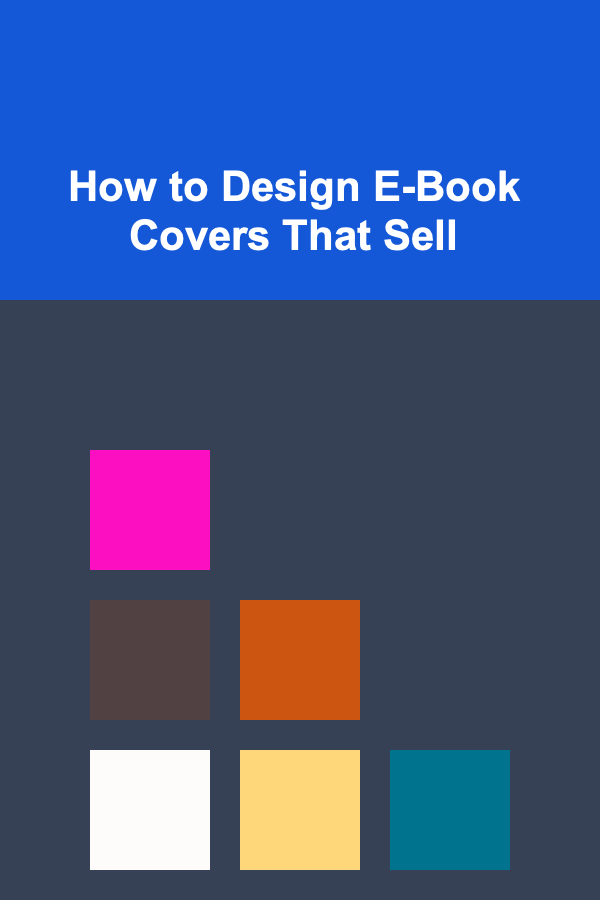
How to Design E-Book Covers That Sell
ebook include PDF & Audio bundle (Micro Guide)
$12.99$10.99
Limited Time Offer! Order within the next:

In the world of digital publishing, the e-book cover is one of the most crucial elements for attracting readers. It serves as the first point of interaction between the book and the potential reader, and its design can greatly influence whether or not someone decides to click on your book and read the description. An effective e-book cover can increase sales, while a poorly designed one can turn potential buyers away. But what makes an e-book cover truly sell? In this article, we'll explore the process of designing e-book covers that captivate and compel, from understanding the fundamentals of design to the latest trends in cover art.
The Psychology Behind E-Book Covers
Before we dive into the technical aspects of design, it's essential to understand the psychology that underpins the success of a cover. Readers don't just look for an image that "looks nice"; they are drawn to covers that communicate certain emotions, themes, and even genre expectations. The e-book cover must not only be visually appealing but must also instantly convey what the book is about and what kind of experience a reader can expect.
1. The Role of First Impressions
Psychologists suggest that humans form first impressions in milliseconds. This means that the cover is your book's first and possibly only chance to make an impact. An effective cover design needs to instantly communicate the genre, tone, and theme of the book without requiring much thought from the viewer. Whether it's the mysterious allure of a thriller or the soft, whimsical vibe of a romance novel, the cover should provide a snapshot of what the reader can expect inside.
2. Color Psychology
Colors evoke emotions and set expectations. In marketing, color psychology has long been used to influence decisions, and it applies equally to e-book covers. For instance:
- Red can convey urgency or passion, often used in romance, thrillers, or action genres.
- Blue communicates calm, trust, and security, making it a common choice for mysteries, self-help books, or books with a professional tone.
- Green signifies growth and tranquility, often used in health, wellness, or environmental books.
- Black or dark colors can denote mystery or sophistication, typically found in horror or crime novels.
Choosing the right color palette can set the stage for how the book is perceived and whether it aligns with the expectations of the target audience.
3. Typography and Font Choices
Fonts play a huge role in conveying the feel of your e-book. The font should reflect the genre, target audience, and tone of your book. For example:
- Serif fonts (such as Times New Roman) give a classic, formal vibe and are often used for historical fiction or literary works.
- Sans-serif fonts (like Arial) provide a clean, modern look, suitable for self-help books, tech publications, or business genres.
- Script fonts suggest elegance, romance, and artistic themes and can be used for books in those categories.
- Bold or heavy fonts are used in action-packed or horror books to convey a sense of urgency or drama.
When designing your e-book cover, ensure that the typography complements the imagery and the overall tone of your book.
Key Principles of E-Book Cover Design
When designing an e-book cover, several core principles guide the creation of an effective and attractive design. These principles help ensure that your cover will stand out in a crowded marketplace and appeal to the right audience.
1. Simplicity is Key
A cluttered, overly complex cover can be confusing and off-putting. While it might seem tempting to incorporate numerous elements or intricate details, less is often more. Simplicity allows the essential elements of the cover to shine, and it ensures that the book remains legible and recognizable, even at smaller sizes on e-commerce platforms.
E-book covers often appear as thumbnails in online marketplaces, so it's crucial that your design looks just as good at a small scale as it does at full size. Avoid excessive text, intricate images, or too many visual elements. Focus on a central, clear image and concise, easy-to-read text.
2. Consistency with Genre Expectations
Different genres have different expectations when it comes to cover design. Readers are often looking for visual cues that tell them what kind of book they are about to pick up. A book cover for a horror novel should be darker and more ominous, whereas a cover for a young adult romance might be lighter, brighter, and feature more whimsical or dreamy elements.
While it's important to stay on-brand with genre conventions, this doesn't mean that creativity should be stifled. Think about how you can break free from clichés within a genre while still satisfying its visual expectations. For instance, a romance novel could use a modern, minimalist cover, which stands out in a market dominated by pastel-colored, heavily-illustrated covers.
3. Legibility of Text
One of the most important factors in an e-book cover is legibility. While striking imagery is important, the text---the title and author name---must be easy to read. In fact, the primary purpose of the cover is to present the title and make it visible to potential readers, so it's vital that your typography is clear, bold, and contrasts well with the background.
Avoid overly decorative fonts or colors that clash with the background image. The title should be the focal point, and the author's name should be present but secondary. Remember that many potential readers will first see your cover as a thumbnail on an online store, so it must be legible even in small form.
4. Imagery That Represents the Story
The imagery on the cover must tie into the themes and plot of the book. A cover design should tell a story in itself, even before the reader opens the book. If the book is about a mystery set in a foggy forest, the cover might feature trees shrouded in mist. If it's about a historical event, consider imagery that evokes the time period and atmosphere of that moment in history.
The images used in the cover need to be high-quality and relevant. A blurry, irrelevant, or overly abstract image can confuse readers and detract from the book's potential appeal.
5. Uniqueness
In a crowded marketplace, standing out is essential. An e-book cover must catch the eye of the reader amid hundreds, if not thousands, of other books. Think about how your design will differentiate your book from others in the same genre. How can you visually communicate the essence of your book while being distinct from others?
This might involve choosing a striking color scheme, opting for an unconventional image, or presenting a twist on traditional cover art within your genre.
Technical Considerations for E-Book Covers
Once you have a solid understanding of the visual and psychological elements that make an e-book cover appealing, it's time to consider the technical aspects of design.
1. Size and Resolution
E-book covers need to be the right size and resolution to ensure that they look sharp and professional across all devices and marketplaces. While specific requirements may vary between platforms (Amazon Kindle, Apple Books, etc.), a common recommendation is:
- Minimum size: 1400 x 2100 pixels (for Amazon Kindle, for example).
- Resolution: 300 DPI (dots per inch) for a high-quality image. This ensures that the cover is high-resolution enough to display well on various screen sizes, from smartphones to tablets to e-readers.
2. File Format
The file format for an e-book cover should typically be either JPEG or PNG. JPEGs are a good choice for photographs, while PNGs are ideal for images with transparent backgrounds or graphic designs. Be mindful of file size, as oversized images can slow down page loading times on online platforms.
3. Aspect Ratio
E-book covers typically use a 1.6:1 aspect ratio (height:width), meaning that the cover is taller than it is wide. This ratio works well on most devices and platforms, ensuring that your cover maintains its proportions and doesn't appear stretched or distorted.
4. Platform Guidelines
Each e-book marketplace has its own set of guidelines and specifications for cover design. Be sure to review the requirements for platforms like Amazon Kindle, Apple Books, and Barnes & Noble before finalizing your design. Adhering to these guidelines will ensure that your cover looks professional and functions well across all distribution channels.
Tools and Resources for Designing E-Book Covers
You don't have to be a graphic designer to create a professional-looking e-book cover. With the right tools, anyone can design an eye-catching cover that sells. Here are a few tools and resources that can help you get started:
1. Canva
Canva is an online design tool that offers an intuitive interface and templates for e-book covers. Even beginners can use Canva's drag-and-drop features to create visually appealing designs. The platform offers templates based on different genres, making it easier to start.
2. Adobe Photoshop
For those with more advanced design skills, Adobe Photoshop offers complete flexibility in designing a unique e-book cover. You can create custom graphics, manipulate images, and experiment with typography to create a professional and polished design.
3. Book Brush
Book Brush is a tool specifically built for authors and publishers to create e-book covers. It offers a range of templates, images, and customization options, making it easier for non-designers to create an attractive cover.
4. Unsplash and Pexels
High-quality images can make or break a book cover. Websites like Unsplash and Pexels offer free, high-resolution stock photos that can be used for commercial purposes. These platforms have extensive libraries of photos across various genres, so you're likely to find just the right image for your cover.
Final Thoughts
Designing an e-book cover that sells requires a blend of psychology, design principles, technical knowledge, and creativity. Your cover must not only attract attention but also convey the essence of your book, evoke the right emotions, and entice potential readers to learn more.
By focusing on the key principles of simplicity, genre expectations, legibility, and imagery, while also considering the technical aspects of size, resolution, and file formats, you can create a cover that stands out and effectively represents your book.
Remember, your e-book cover is the first impression readers will have of your work. Make it count.

How to Make a Checklist for Optimizing Website Images and Media
Read More
How to Revamp Your Home's Exterior Without a Full Renovation
Read More
How to Utilize ChatGPT for Language Translation
Read More
The Digital Marketing Manager's Playbook: Driving Growth in the Digital Age
Read More
How to Use Blockchain for Gaming
Read More
Understanding the Gut-Brain Axis: A Deep Dive into the Microbiome's Influence
Read MoreOther Products

How to Make a Checklist for Optimizing Website Images and Media
Read More
How to Revamp Your Home's Exterior Without a Full Renovation
Read More
How to Utilize ChatGPT for Language Translation
Read More
The Digital Marketing Manager's Playbook: Driving Growth in the Digital Age
Read More
How to Use Blockchain for Gaming
Read More